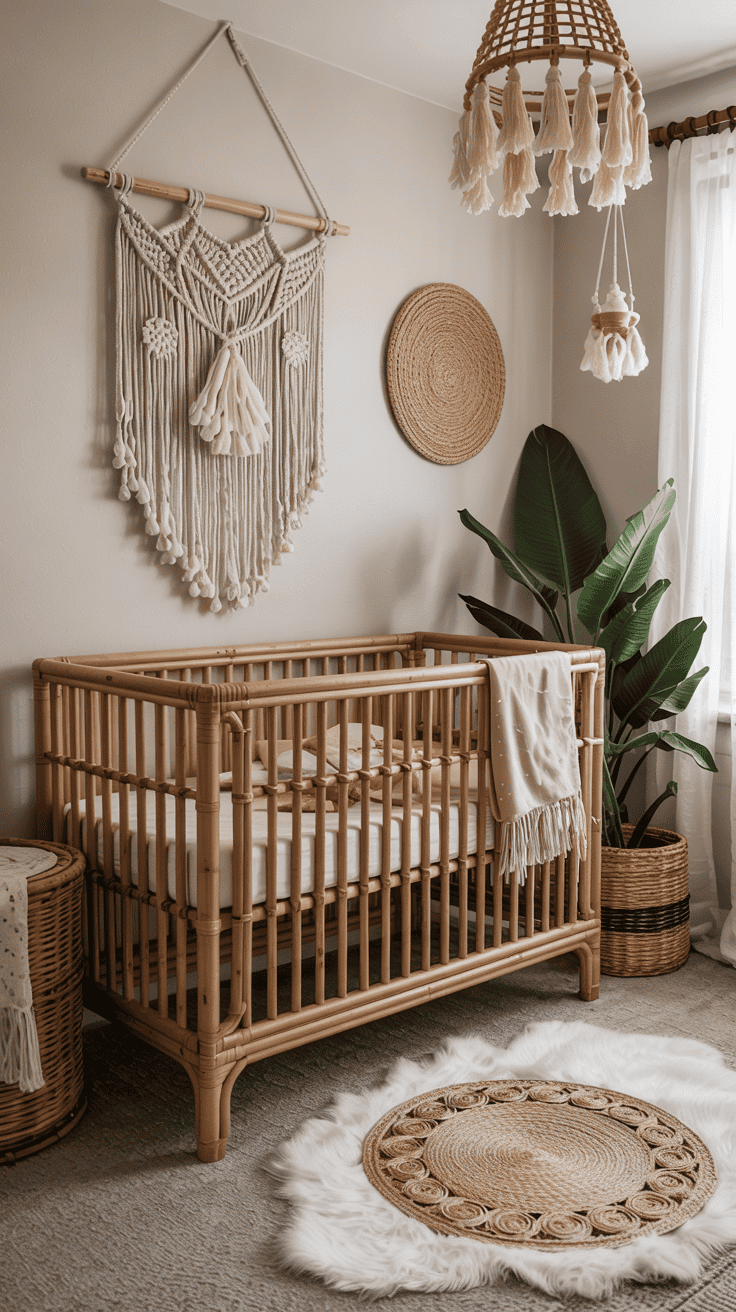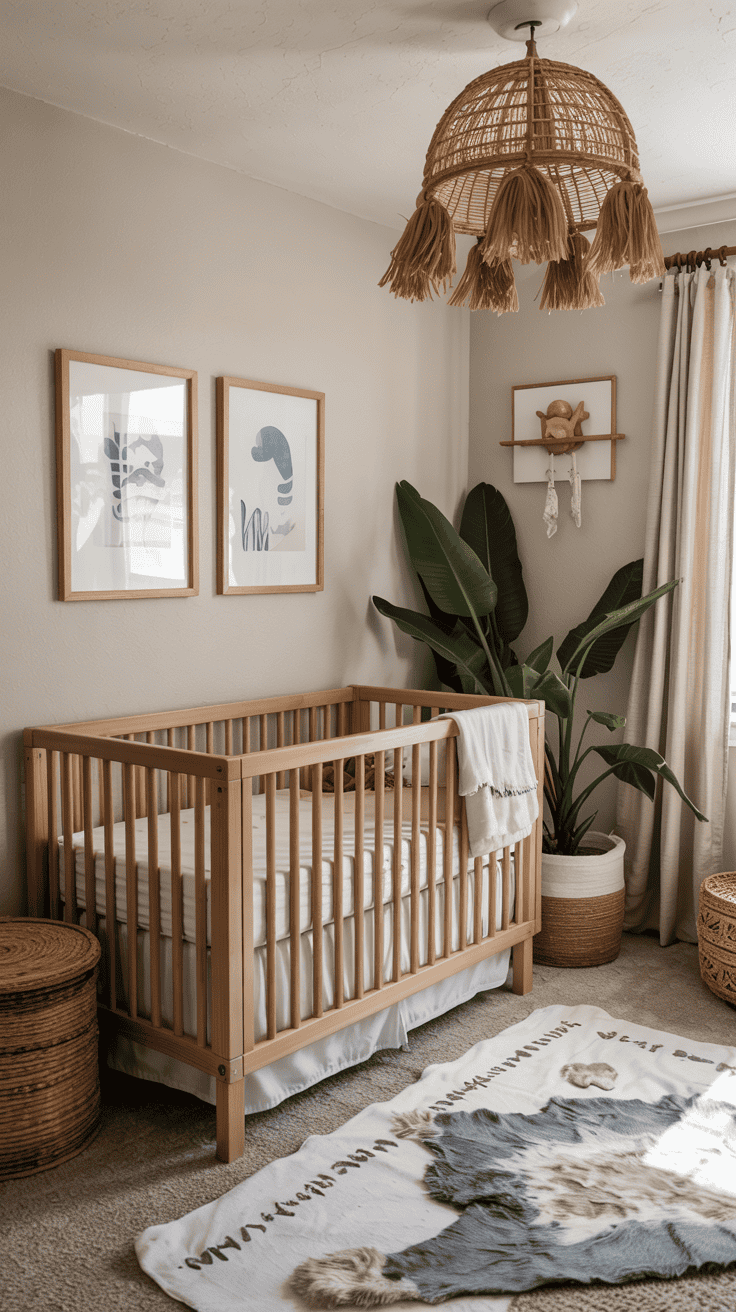This post shows 15 Boho Rainbow Nursery Ideas!
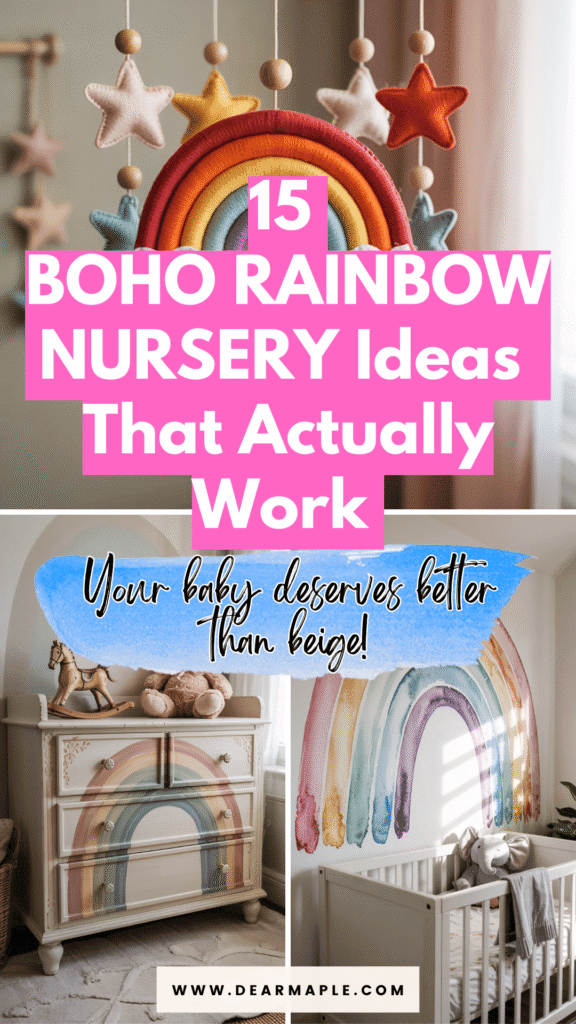
Look, I get it. You’ve probably scrolled through countless nursery inspiration photos filled with beige walls, cream everything, and maybe—if you’re lucky—a pop of sage green. Yawn. While neutral nurseries had their moment, let’s be honest: your baby deserves better than living in what looks like an upscale cardboard box.
I’m here to shake things up with boho rainbow nursery ideas that actually work. We’re talking about spaces that feel like magical sanctuaries without looking like a unicorn exploded. Ready to create something your future toddler will thank you for? Let’s get colorful.
Why Rainbow Nurseries Actually Make Sense
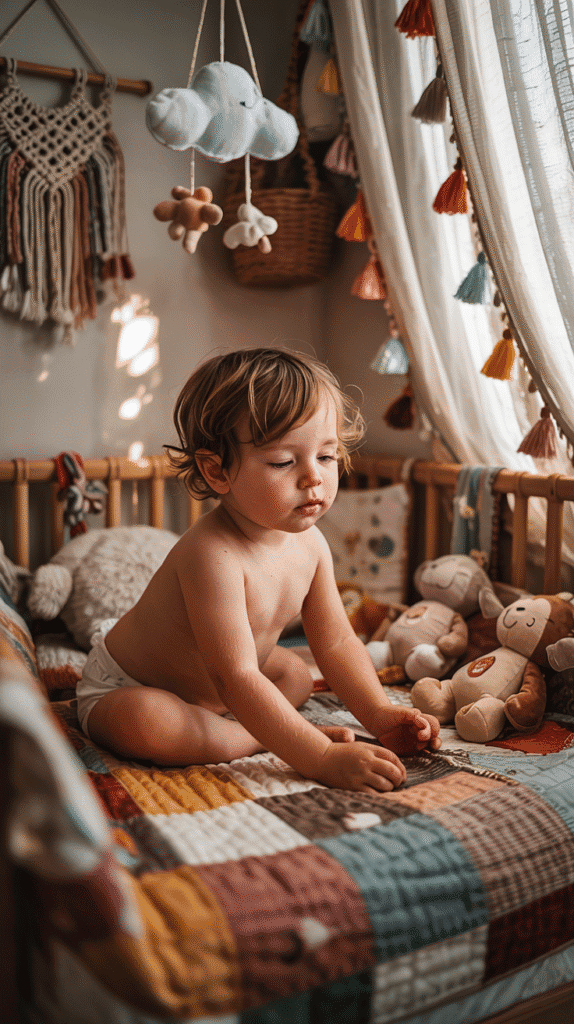
Before you roll your eyes thinking I’ve lost my mind, hear me out. Rainbow nurseries aren’t just pretty—they’re smart. Research shows that colorful environments stimulate cognitive development in babies. Plus, let’s face it: you’ll be spending countless hours in this room. Wouldn’t you rather stare at something that sparks joy instead of making you feel like you’re trapped in a minimalist prison?
The boho approach to rainbow design brings balance and sophistication to what could easily become overwhelming. We’re using natural textures, organic shapes, and muted tones that create harmony instead of chaos.
1. Watercolor Rainbow Accent Wall
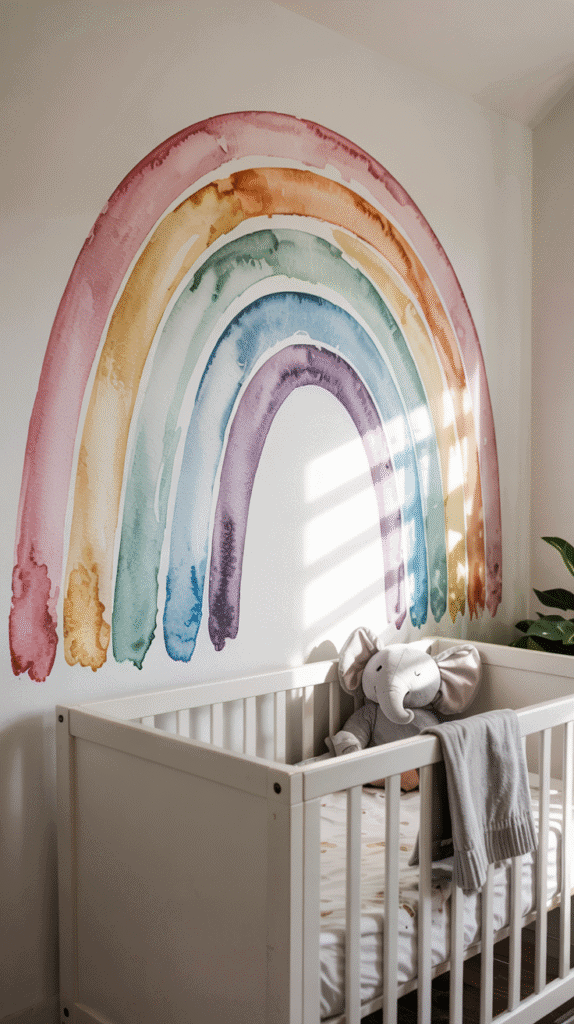
This idea transformed my friend’s nursery from “meh” to “magical” in one weekend. Watercolor rainbow walls create the perfect backdrop without screaming for attention.
You’ve got two routes here: hire an artist (if your budget allows) or grab some peel-and-stick watercolor rainbow wallpaper. I personally love the Anewall designs—they look hand-painted but won’t break the bank or your lease agreement.
The beauty of watercolor rainbows lies in their soft, dreamy quality. Instead of bold stripes that might overwhelm a tiny space, these gentle arcs create movement and interest without being too stimulating for naptime. Position this behind the crib or create a reading corner backdrop.
Pro tip: Choose watercolors with a white or cream base to keep things serene. The colors should whisper, not shout. Trust me on this one—I’ve seen what happens when someone goes full neon rainbow, and it’s not pretty at 3 AM during a feeding session.
The key is placement and proportion. Don’t cover every wall—one accent wall does the trick. This approach gives you that wow factor while maintaining the peaceful vibe every nursery needs.
2. Macrame Rainbow Wall Hanging

Nothing says “boho chic” quite like macrame, and rainbow versions are having a serious moment. I stumbled across this trend on Instagram and immediately knew it was genius.
Large-scale macrame rainbow wall hangings work as stunning focal points above cribs or changing stations. The natural cotton fibers add texture and warmth while the rainbow gradient brings that pop of color we’re after.
You can find beautiful handmade pieces on Etsy starting around $50, or if you’re feeling crafty, YouTube has countless tutorials. Fair warning though—macrame takes patience. Like, a lot of patience. I tried making one myself and gave up after two hours of tangled cord and mild profanity.
The ombré effect in macrame rainbows creates visual interest without being too busy. Choose pieces that fade from one color to the next rather than distinct color blocks. This creates a more sophisticated, grown-up feel.
Safety note: Make sure any wall hanging is securely mounted and positioned where little hands can’t reach. The last thing you want is your beautiful art piece becoming a climbing apparatus for a curious toddler.
Position these beauties where they’ll catch natural light—the cotton fibers create lovely shadows that add another layer of visual texture to your space.
3. Layered Rainbow Area Rugs
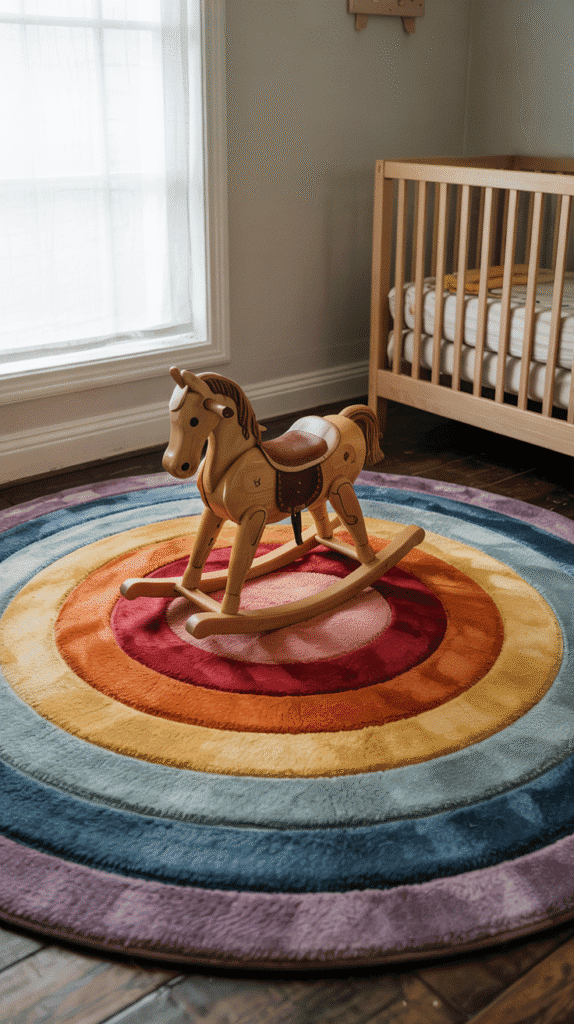
Here’s where things get fun. Layered rugs are having a major moment in interior design, and rainbow versions bring personality to nursery floors in the best way possible.
I love mixing a large neutral jute or natural fiber rug as your base with a smaller rainbow rug on top. This approach gives you that boho layered look while keeping costs reasonable—you don’t need to invest in one massive rainbow rug.
Vintage Persian rugs with rainbow color schemes work beautifully here. Check estate sales, Facebook Marketplace, or even your grandmother’s attic. These pieces bring history and character that new rugs just can’t match.
For modern options, look for rainbow stripe rugs or subtle rainbow motifs. The key is choosing pieces that complement rather than compete. If your wall has a bold rainbow element, go subtle with the rug. If your walls are neutral, this is where you can get more adventurous.
Practical considerations: Choose rugs that can handle spit-up, spilled bottles, and the general chaos babies bring. Machine-washable options are your friend here. Cotton rugs work well, or look for indoor/outdoor rugs that can handle serious cleaning.
The layered approach also means you can switch out the top rug seasonally or as your child grows, keeping the space fresh without major renovations.
4. Rainbow Floating Shelves
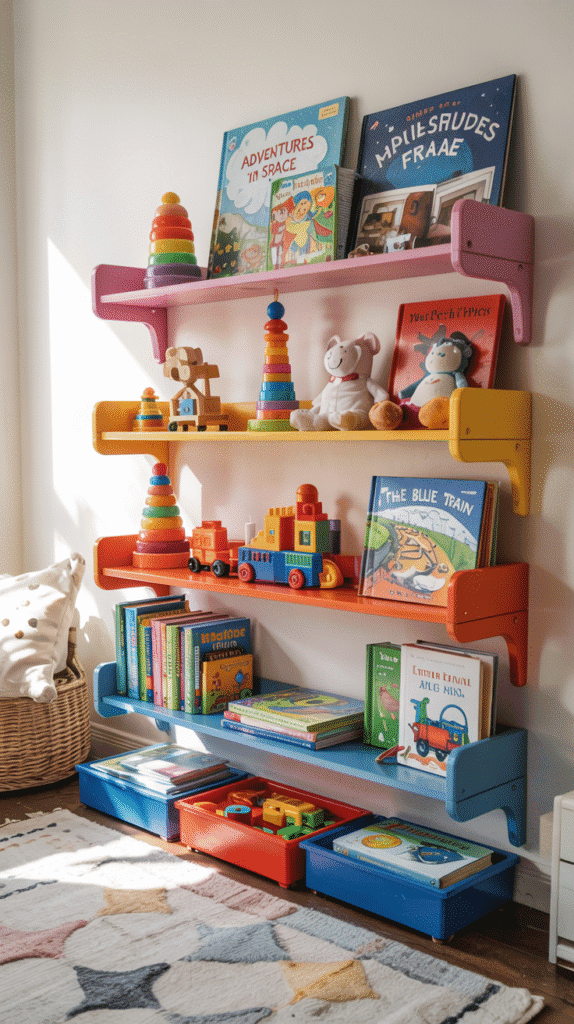
Gradient-colored floating shelves might sound bold, but when done right, they’re absolutely stunning. I first spotted this idea in a design magazine and couldn’t stop thinking about it.
Paint each shelf a different rainbow color, starting with red at the top and working through the spectrum. The trick is choosing muted versions of each color—think dusty rose instead of fire engine red, sage instead of neon green.
These shelves become functional art. Use them to display board books arranged by color, small plants, or treasured keepsakes. The color coordination creates a curated, intentional look that’s anything but childish.
Installation tip: Space shelves evenly and keep them at different heights for visual interest. Three to five shelves usually work best—more than that and the wall starts looking cluttered.
Choose shelves with clean, simple lines. Ornate brackets or decorative elements compete with the rainbow effect. Simple wooden shelves or sleek metal brackets work best.
The beauty of this approach is flexibility. As your child grows, these shelves transition from nursery décor to homework station to teen room storage. It’s décor that grows with your family.
Consider what you’ll display carefully. Books, small plants, or simple decorative objects work well. Avoid cluttering these shelves—the color is the star here.
5. Dreamy Rainbow Canopy
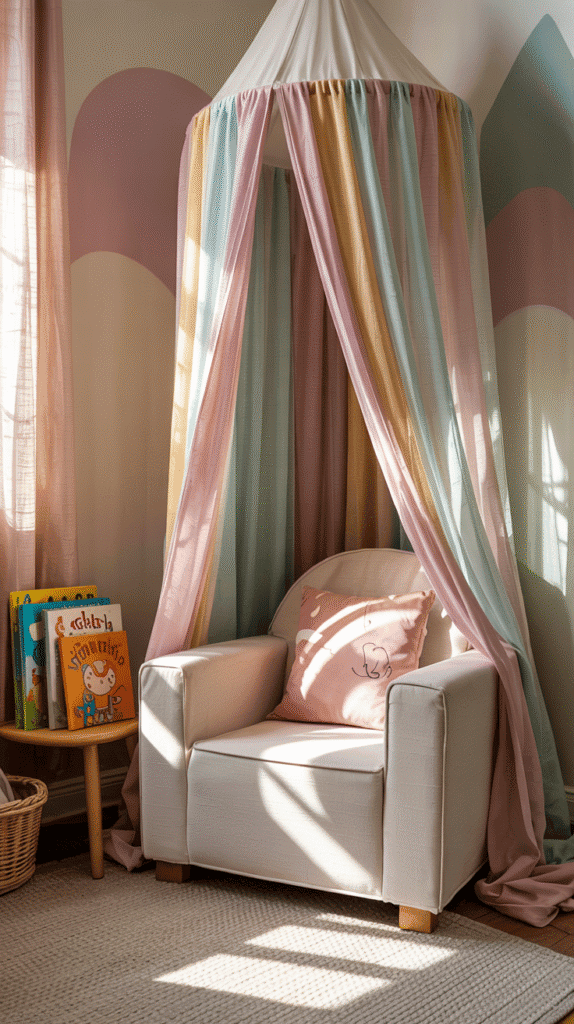
Ceiling-mounted canopies create the coziest reading nooks, and rainbow versions add that magical factor every child deserves. This idea works especially well in rooms with high ceilings.
Choose sheer fabrics in rainbow hues—think chiffon, tulle, or lightweight cotton. The sheerness prevents the canopy from feeling heavy or overwhelming while still providing that dreamy, enclosed feeling kids love.
I recommend creating a dedicated reading corner with a comfortable chair or floor cushions underneath. This becomes your bedtime story spot and eventually your child’s own private retreat.
Installation requires some planning. You’ll need a ceiling hook rated for fabric weight, and consider how the canopy will look from different angles in the room. The draping should feel intentional, not haphazard.
Maintenance matters with fabric canopies. Choose machine-washable materials and plan for regular cleaning. Little hands touch everything, and fabric attracts dust.
The layering effect works beautifully here—start with longer panels in the center and shorter ones on the outside, or mix different textures within the same color family. This creates depth and visual interest.
Safety first: ensure the canopy is well out of reach of cribs or anywhere babies sleep unsupervised. This works best as a toddler-and-up feature.
6. Hand-Painted Rainbow Dresser

This project scared me at first, but the results are so worth it. Hand-painted rainbow dressers become statement pieces that serve double duty as storage and art.
Start with a simple wooden dresser—thrift stores and garage sales are goldmines for these projects. Choose a piece with good bones but boring finish. Each drawer gets its own rainbow color, creating a subtle gradient effect.
Color choice matters enormously. I learned this the hard way after painting a dresser in bright primary colors that looked like a Fisher-Price explosion. Choose muted, sophisticated versions of rainbow colors—dusty pink, sage green, soft lavender.
The technique is straightforward: sand, prime, paint, and seal. But here’s what I wish someone had told me: use high-quality paint and primer. Cheap paint chips and scratches easily, especially on frequently-used furniture.
Hardware makes a difference. Brass or gold pulls elevate the whole piece and tie into that boho aesthetic we’re after. Don’t skip this detail—it’s what separates DIY disasters from designer looks.
Consider the room’s overall color scheme. This dresser should complement, not compete with other rainbow elements. If you’ve got a bold rainbow wall, keep the dresser more subtle.
This piece grows with your child beautifully. What starts as whimsical nursery storage becomes a beloved childhood furniture piece and eventually a teenager’s unique dresser.
7. Rainbow Mobile with Natural Elements
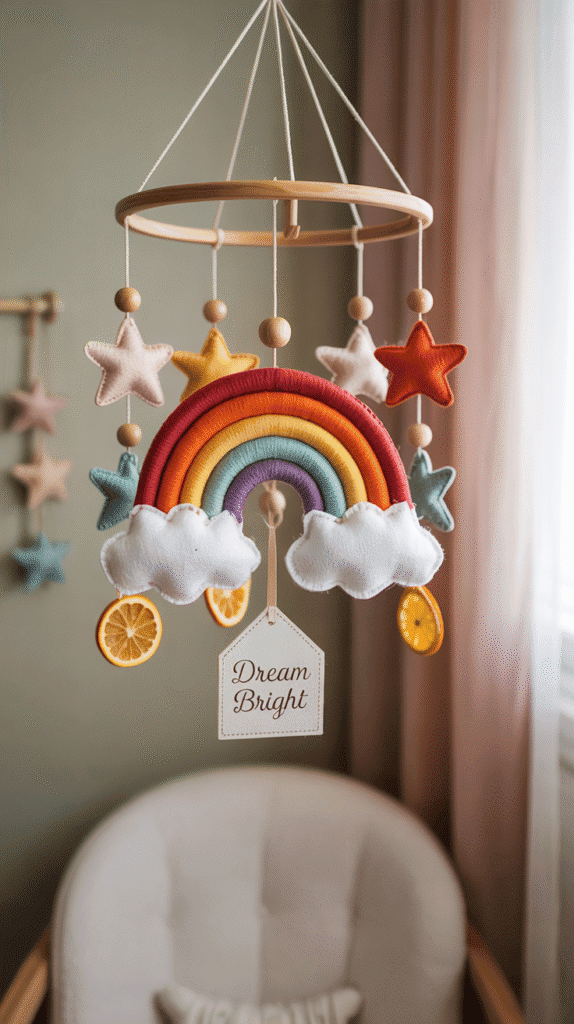
Store-bought mobiles are fine, but handmade rainbow mobiles using natural elements create something truly special. This project combines the rainbow theme with boho natural textures.
Wooden embroidery hoops make perfect mobile bases. Paint them in rainbow colors or leave natural—both approaches work depending on your room’s vibe. I prefer the natural wood approach because it feels more organic and timeless.
Add felt balls, dried flowers, feathers, or small wooden shapes in rainbow order. The key is balancing color with texture. Too much color overwhelms; too little defeats the purpose.
Movement and balance require some patience. You’ll need to adjust placement until everything hangs properly. This isn’t a fifteen-minute project—plan for an afternoon of tweaking and adjusting.
Safety considerations are crucial with mobiles. Everything must be securely attached and positioned well out of baby’s reach. Remove mobiles once babies can sit up or reach for them.
The natural element approach means each mobile is unique. No two pieces of dried lavender or wooden bead look identical, giving your mobile character that mass-produced versions lack.
Consider seasonal variations—add pussy willows in spring, dried sunflowers in fall. This keeps the mobile fresh and connects your child to natural rhythms.
Position mobiles where they’ll catch light and air movement. The gentle motion and play of light and shadow add another sensory element to the nursery experience.
8. Gradient Window Treatments
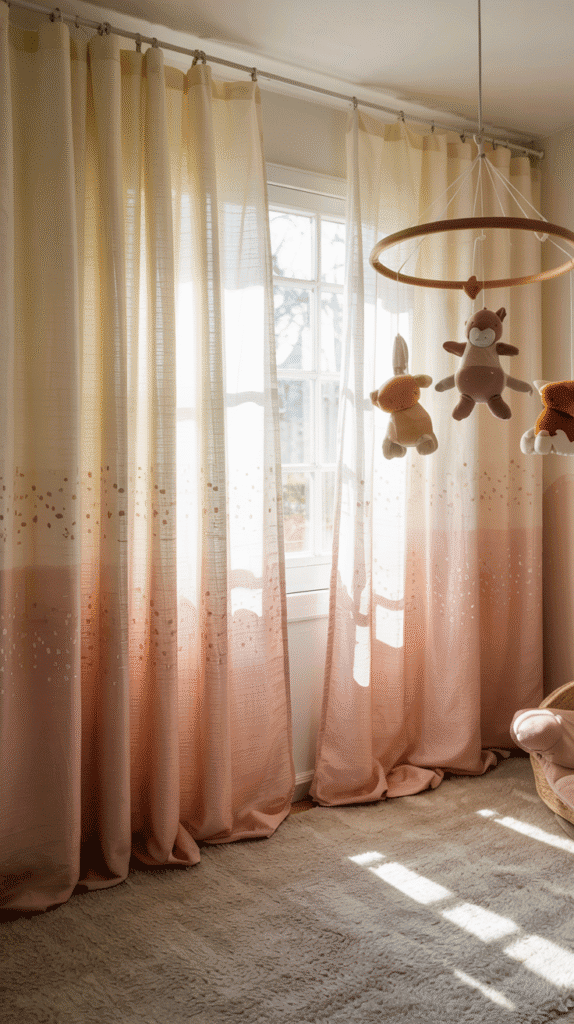
Ombré curtains might sound like a 2010s throwback, but in nurseries, they’re timeless magic. I discovered this trick when trying to soften harsh afternoon light in a west-facing nursery.
You’ve got several approaches here. Dip-dye techniques work well for cotton curtains—start with white panels and gradually dye them in rainbow segments. YouTube has excellent tutorials for this process.
Pre-made gradient curtains save time and guarantee professional results. Companies like West Elm and Anthropologie offer beautiful options, though they’re pricier than DIY versions.
The light filtration aspect matters more than you might think. Gradient curtains diffuse light beautifully, creating soft, colorful glows throughout the day. This natural color play changes your room’s mood from morning to evening.
Hanging height affects the entire room’s proportions. Hang curtains close to the ceiling and let them puddle slightly on the floor—this makes ceilings look higher and rooms feel more spacious.
Consider the direction of your gradient. Light to dark top-to-bottom feels grounding, while dark to light creates an uplifting effect. Match this to your room’s natural light patterns.
Blackout lining becomes crucial for nurseries. Beautiful gradient curtains lose their appeal quickly if they don’t help with nap time. Most gradient curtains can accommodate blackout lining without affecting their appearance.
The beauty of this approach is subtlety. Gradient curtains add rainbow elements without overwhelming small spaces, making them perfect for apartments or rooms with lots of other colorful elements.
9. Rainbow String Light Mason Jars

This idea combines ambient lighting with rainbow elements in the most charming way. I first tried this for a baby shower and loved it so much I kept them up permanently.
Colored mason jars with battery-operated string lights create magical accent lighting perfect for nurseries. Choose jars in rainbow colors—red, orange, yellow, green, blue, purple—and fill each with warm white fairy lights.
Placement options are endless. Line them up on a shelf, hang them at different heights, or group them in a corner reading nook. I love clustering them on floating shelves for layered lighting effects.
Battery-operated lights are non-negotiable for nurseries. No cords, no electrical hazards, just safe, beautiful ambiance. The newer LED versions last for weeks on single battery sets.
Color intensity matters here. Deep jewel tones create richer light than pale pastels. Think ruby red, amber orange, emerald green—colors that glow beautifully when lit from within.
The mason jar aesthetic fits perfectly with boho design elements. These aren’t precious décor pieces—they’re functional, casual, and kid-friendly. When your toddler inevitably knocks one over, you’re out five dollars, not fifty.
Seasonal flexibility keeps things interesting. Add seasonal elements like pinecones in winter or flower petals in spring. The jars become vessels for creativity as your child grows.
Consider timer functions on your string lights. Lights that automatically turn on at dusk and off at dawn create consistent ambiance without daily management.
10. Woven Rainbow Basket Storage
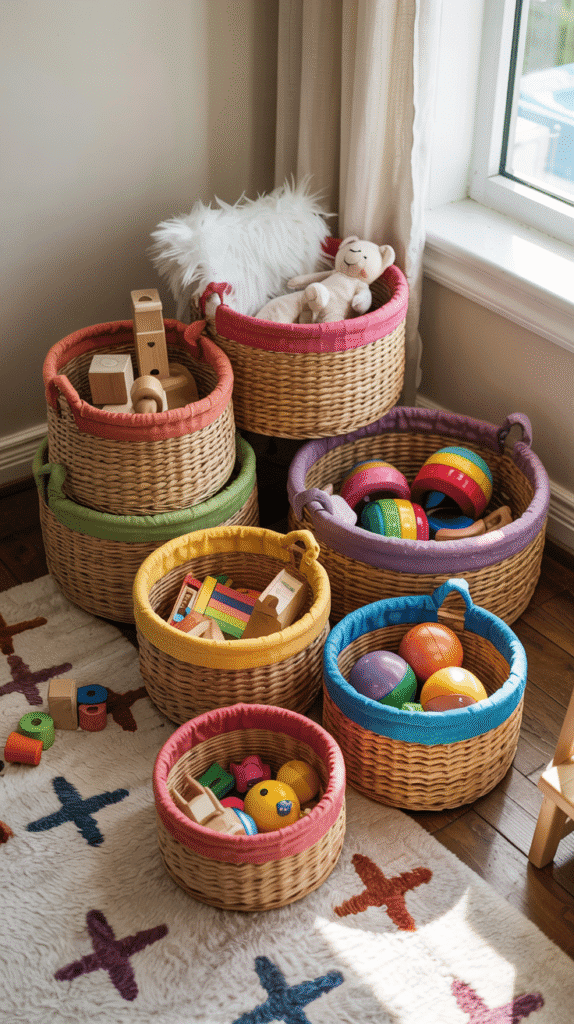
Natural storage solutions that incorporate rainbow elements solve two problems at once—organization and decoration. Woven baskets bring that essential boho texture while keeping toys contained.
Look for seagrass, rattan, or wicker baskets and add rainbow elements through handles, trim, or dip-dyed bottoms. This approach maintains the natural material’s beauty while adding your color theme.
Size variety creates visual interest and functional flexibility. Large baskets for stuffed animals, medium ones for books, small ones for tiny treasures. Group them in clusters or line them up on shelves.
DIY rainbow touches are easier than you might think. Fabric paint, rope wrapping, or even colorful ribbon handles transform plain baskets into rainbow storage solutions. I’ve had great success with fabric paint on basket rims—just tape off clean lines and paint away.
Labeling systems help as children grow. Simple picture labels or color-coded systems teach organization while maintaining the rainbow theme. This turns cleanup into a matching game rather than a chore.
The durability factor makes baskets practical long-term investments. Unlike plastic storage that breaks or becomes dated, quality woven baskets age beautifully and transition through different décor phases.
Mobility matters with basket storage. Choose pieces with comfortable handles that little hands can eventually manage. Storage that children can use independently builds confidence and responsibility.
Consider basket placement carefully. Floor-level baskets become toy boxes, shelf-height baskets store out-of-reach items, and hanging baskets add vertical storage without floor clutter.
11. Rainbow Prism Sun Catchers

Crystal prism window hangings create the most magical natural light shows, and they’re probably the easiest rainbow element to add to any nursery. I discovered these during a visit to a friend’s light-filled nursery and immediately ordered some for my own space.
Placement near windows transforms ordinary sunlight into dancing rainbow patterns across walls and ceiling. The effect changes throughout the day as the sun moves, creating ever-changing natural entertainment.
Crystal quality affects the rainbow intensity dramatically. Cheap plastic prisms create weak, blurry rainbows, while quality lead crystal produces brilliant, clear color spectrums. It’s worth investing in good pieces—they last forever and perform beautifully.
Hanging techniques require some thought. Suction cup hangers work for renters, while small ceiling hooks provide more permanent solutions. Vary the heights and positions for multiple rainbow effects throughout the room.
Safety considerations mean positioning prisms where children can’t reach them but where they’ll still catch optimal light. South-facing windows usually provide the best rainbow displays.
The natural element aspect fits perfectly with boho design philosophy. These aren’t artificial decorations—they’re tools that reveal the hidden beauty in everyday sunlight. There’s something deeply satisfying about décor that works with natural forces.
Seasonal changes affect prism performance. Summer’s high sun creates different patterns than winter’s low angles. This natural variation keeps the light show interesting year-round.
Multiple prisms create layered effects without overwhelming the space. Three to five prisms in one window usually provide optimal rainbow coverage without creating chaos.
12. Boho Rainbow Throw Pillow Collection
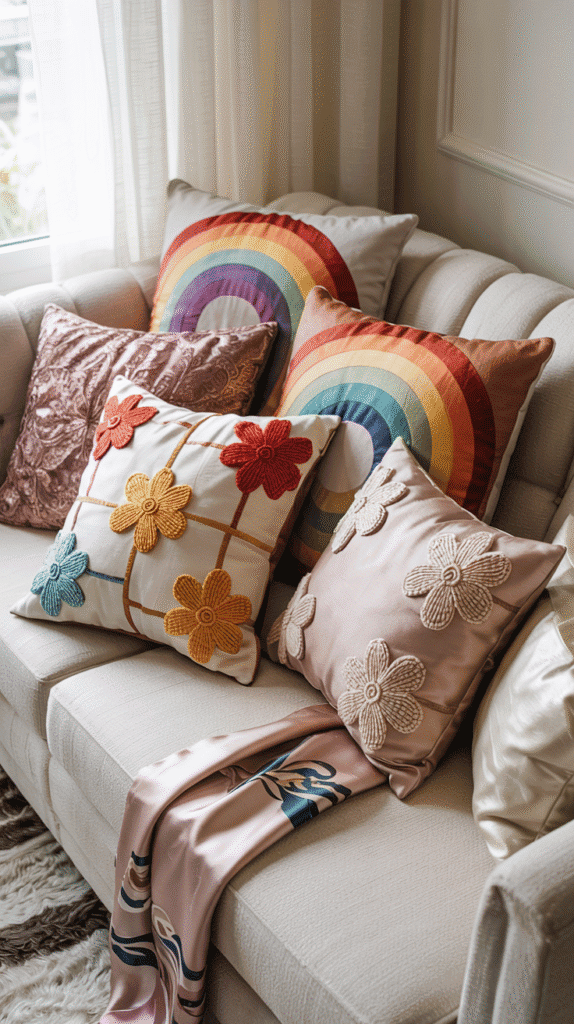
Mixing patterns and textures in throw pillows lets you experiment with rainbow elements without major commitment. I love this approach because you can easily swap pillows seasonally or as trends change.
Pattern mixing works beautifully when you stick to a consistent color palette. Combine tie-dye, stripes, florals, and geometric prints in the same rainbow colors. The variety creates visual interest while the consistent colors maintain harmony.
Texture variety adds that crucial boho element. Mix velvet, linen, cotton, and maybe some macrame or embroidered pieces. Different textures catch light differently, adding depth to your color scheme.
Size variation creates professional-looking arrangements. Use 18-inch pillows as anchors, 16-inch pillows as mid-size elements, and 12-inch pillows as accents. Odd numbers work better than even—three or five pillows look more natural than four or six.
Placement options extend beyond typical couch arrangements. Floor pillows create cozy reading nooks, chair pillows add comfort to nursing stations, and bed pillows bring color to adult furniture in the nursery.
Quality considerations matter more with pillows than you might expect. Cheap pillow covers fade, shrink, or pill after washing. Invest in good cotton or linen covers that’ll maintain their beauty through frequent cleaning.
Washability becomes crucial in nurseries. Choose covers that can handle regular washing without losing shape or color. Hidden zippers work better than buttons or ties that might pose choking hazards later.
Storage solutions for seasonal pillow swaps help maintain organization. Clear bins labeled by season or color scheme make switching pillows a quick, enjoyable process rather than a chaotic hunt through closets.
13. Living Rainbow Plant Wall
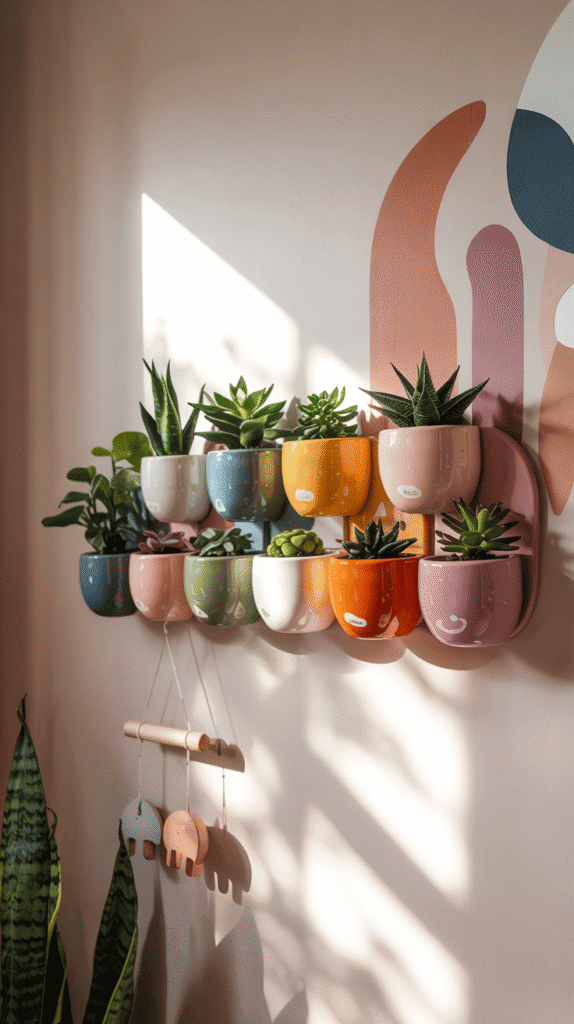
Child-safe plants arranged in rainbow-colored planters bring life and color to nursery walls while teaching children about nature from day one. This idea combines the rainbow theme with biophilic design principles.
Plant selection requires careful research. Choose spider plants, pothos, rubber trees, or snake plants—all non-toxic options that thrive indoors. Avoid anything poisonous because curious toddlers taste everything.
Planter arrangement creates the rainbow effect. Use ceramic pots in rainbow colors or paint terra cotta pots in your chosen spectrum. Arrange them in a gentle arc or straight line depending on your wall space.
Wall mounting systems need to support both planter weight and watering needs. Look for wall-mounted planter systems designed for indoor use, or create your own using sturdy brackets and waterproof backing.
Maintenance requirements mean this isn’t a set-and-forget décor choice. Plants need regular watering, occasional fertilizing, and periodic pruning. But the benefits—improved air quality, natural beauty, and educational opportunities—make the effort worthwhile.
Growth considerations affect long-term appearance. Plants don’t stay the same size forever. Plan for growth or choose slower-growing varieties if you want consistent proportions.
Lighting needs might require supplemental grow lights, especially in rooms without optimal natural light. Modern LED grow lights are energy-efficient and barely noticeable when integrated well.
Child involvement becomes possible as kids grow. Watering plants, checking for new growth, and learning plant names creates ongoing interaction with the rainbow garden you’ve created.
14. Rainbow Color-Coordinated Book Display
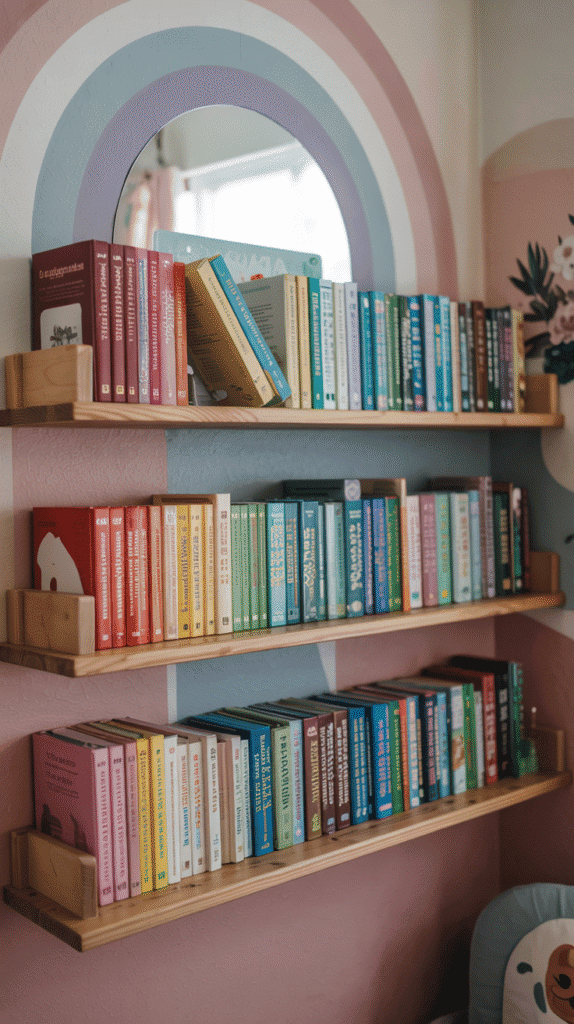
Color-coordinated book collections create stunning visual displays while encouraging literacy from the start. This approach turns necessary book storage into intentional décor.
Sorting by color transforms random book collections into rainbow art installations. Group reds together, then oranges, yellows, and so on. The effect is surprisingly sophisticated and creates order from what could be visual chaos.
Display techniques matter enormously. Face-out displays work better than spine-out for color coordination and help little hands identify books. Mix face-out and spine-out arrangements for visual variety.
Book selection becomes more intentional when you’re considering color. This naturally leads to diverse, beautiful book collections as you seek out specific colors. It’s actually improved my book-buying decisions—I’m more thoughtful about each addition.
Floating shelves work beautifully for rainbow book displays. Mount them at different heights and depths for a dynamic, modern look that grows with your child.
Accessibility changes as children develop. Start with books at adult height for safety, then gradually move age-appropriate books to child-accessible levels as motor skills develop.
Maintenance requires occasional reorganization as your collection grows. New books need to find their color homes, and worn books might need replacing. It’s oddly satisfying to maintain—like organizing colored pencils.
Educational benefits emerge naturally. Children learn colors, develop organizational skills, and begin understanding that books are treasured objects worthy of care and attention.
15. Vintage Rainbow Quilt Feature
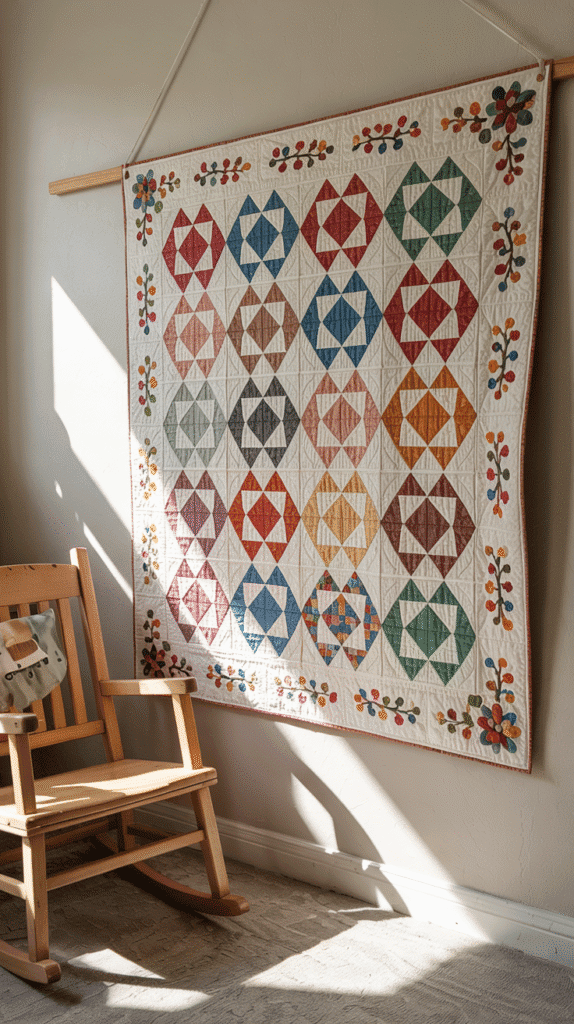
Antique or handmade quilts with rainbow patterns bring history, craftsmanship, and color to nursery walls in the most beautiful way. This final idea ties together all our boho rainbow elements with timeless textile art.
Sourcing vintage quilts becomes a treasure hunt. Check estate sales, antique malls, online marketplaces, and family attics. Look for quilts with good bones—some wear adds character, but avoid pieces with structural damage.
Hanging techniques protect valuable textiles while displaying them properly. Quilt hanging sleeves distribute weight evenly and prevent stretching. Never use nails or staples directly on vintage fabric.
Condition considerations affect placement and use. Display-only quilts work well as wall art, while sturdier pieces might function as actual bedding or play mat covers. Be realistic about each quilt’s remaining lifespan.
Color matching your room’s palette might require patience. True rainbow quilts are somewhat rare—most feature two or three colors. But the search becomes part of the enjoyment, and unexpected color combinations often work beautifully.
Handmade alternatives give you complete control over colors and patterns. If you’re quilting-inclined, create exactly what your space needs. If not, commission local quilters—many appreciate having their work loved and used.
Storytelling potential makes vintage quilts especially meaningful. Research your quilt’s pattern name, approximate age, and regional characteristics. These stories become part of your child’s heritage and connection to textile traditions.
Investment value means quality quilts often appreciate over time. You’re not just buying décor—you’re acquiring heirloom pieces that can pass through generations while serving practical purposes today.
Bringing It All Together
Here’s the thing about creating a boho rainbow nursery—it’s not about using every single idea in one room. That would be overwhelming for everyone involved. Instead, choose three to five elements that speak to you and your space.
Balance remains crucial. If you’ve got a bold rainbow wall, keep other elements more subtle. If your walls are neutral, go bigger with colorful furniture or textiles. The goal is harmony, not sensory overload.
Your child’s personality will emerge over time, and their space should evolve too. Start with elements that can grow and change—baskets that become toy storage, shelves that hold different treasures, quilts that move from wall art to fort-building supplies.
Budget considerations don’t have to limit creativity. Some of the most impactful ideas—like color-coordinated books or DIY painted furniture—cost almost nothing but time and effort. Prioritize based on what you’ll use most and enjoy longest.
The truth is, creating a beautiful nursery isn’t really about the baby—they won’t remember the wall color or carefully arranged books. It’s about creating a space that nurtures your family’s daily life and reflects your values. If those values include beauty, creativity, and joy over boring beige conformity, then rainbow boho nurseries make perfect sense.
Your child will grow up surrounded by color, creativity, and thoughtful design. They’ll learn that spaces can be both beautiful and functional, that homes should reflect personality, and that there’s nothing wrong with choosing joy over convention.
IMO, that’s a pretty great foundation for life 🙂
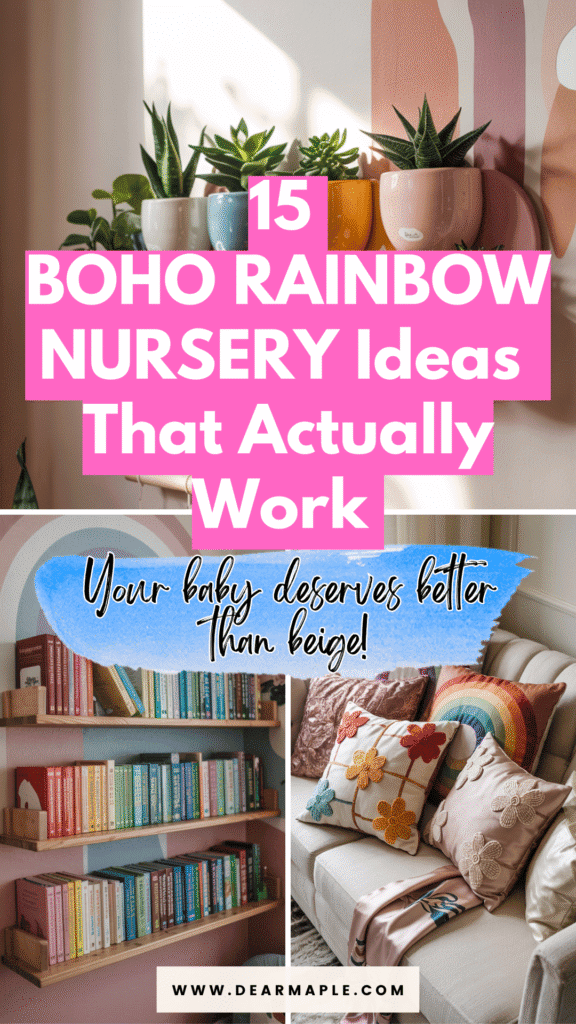
This post shows 15 Boho Rainbow Nursery Ideas!


